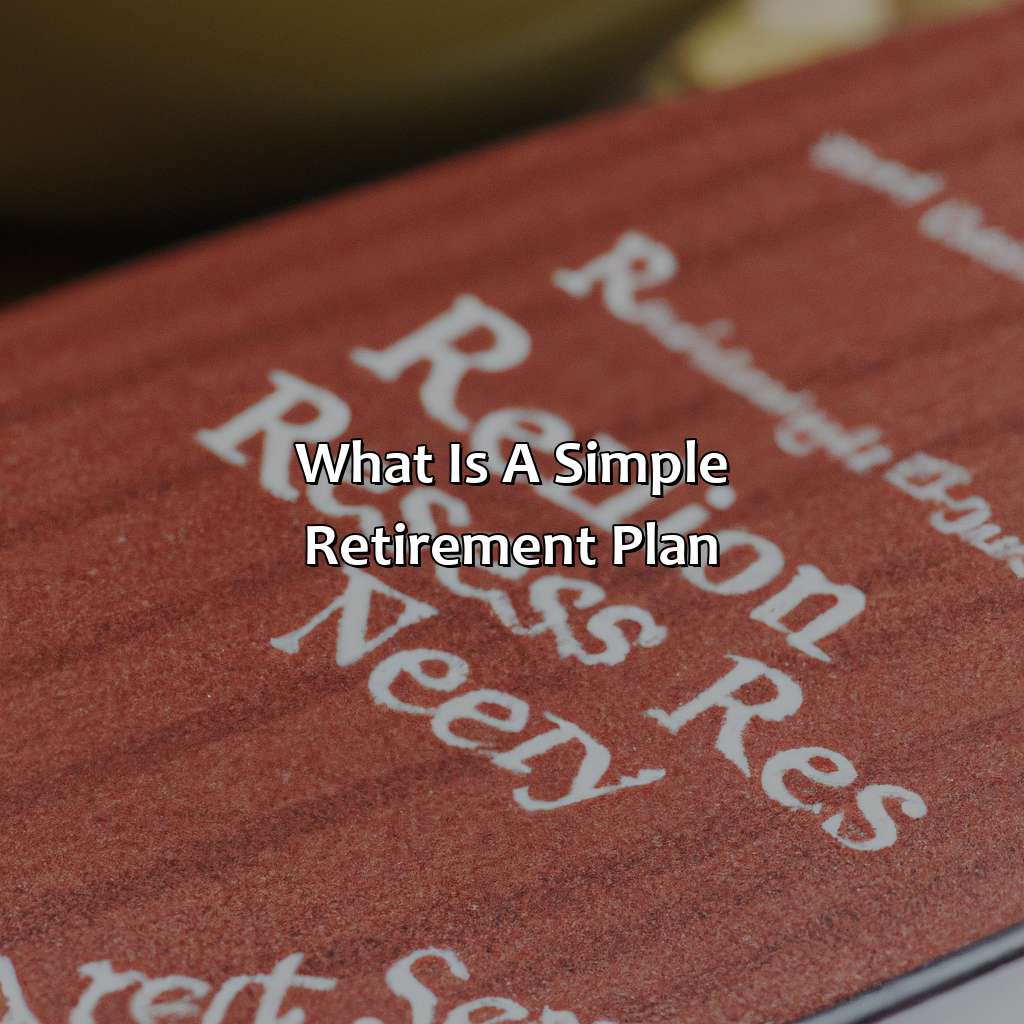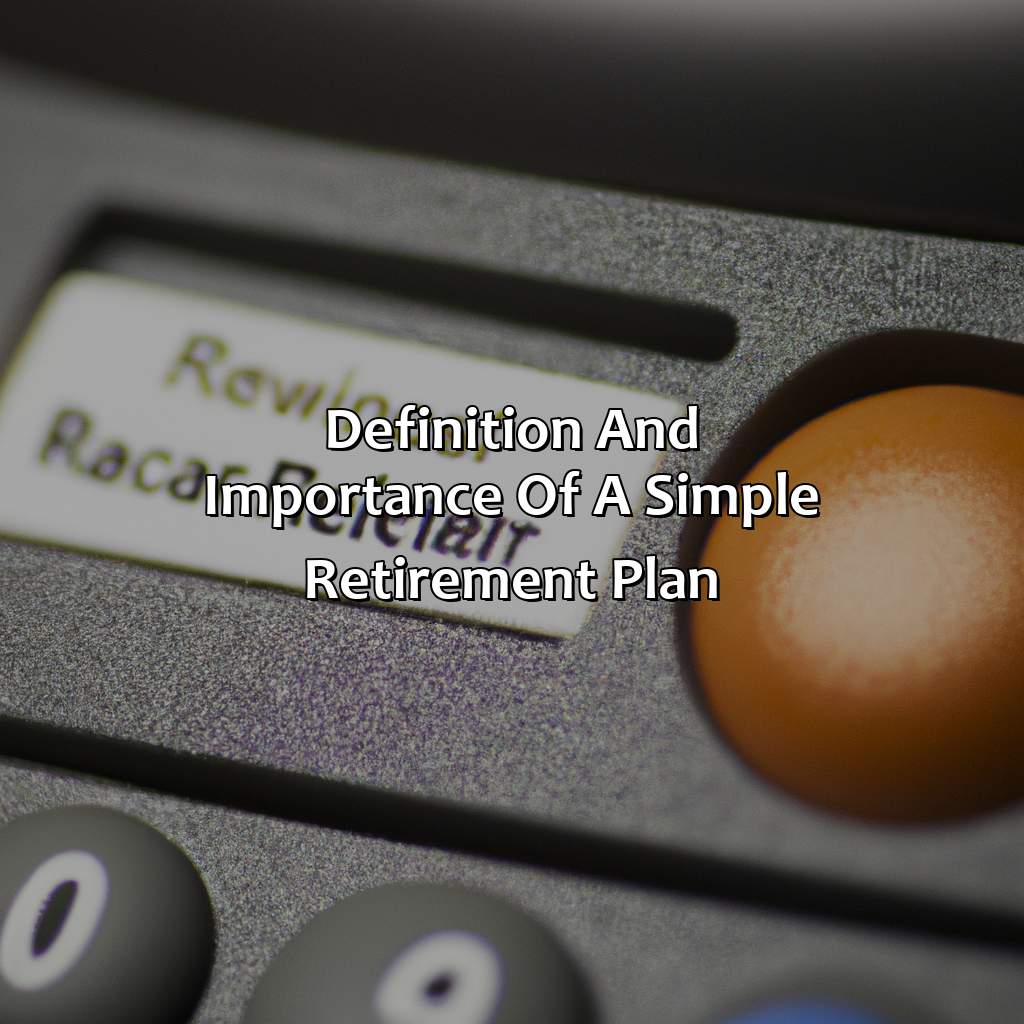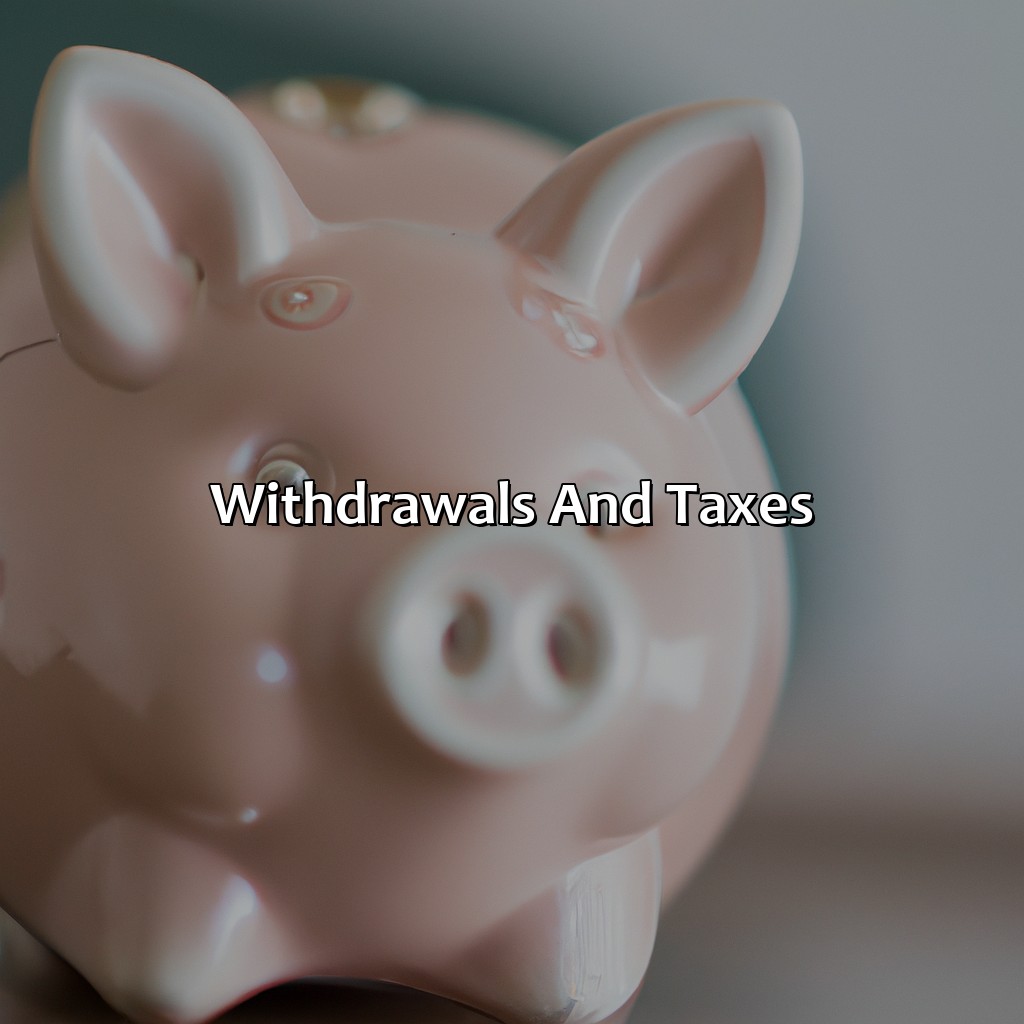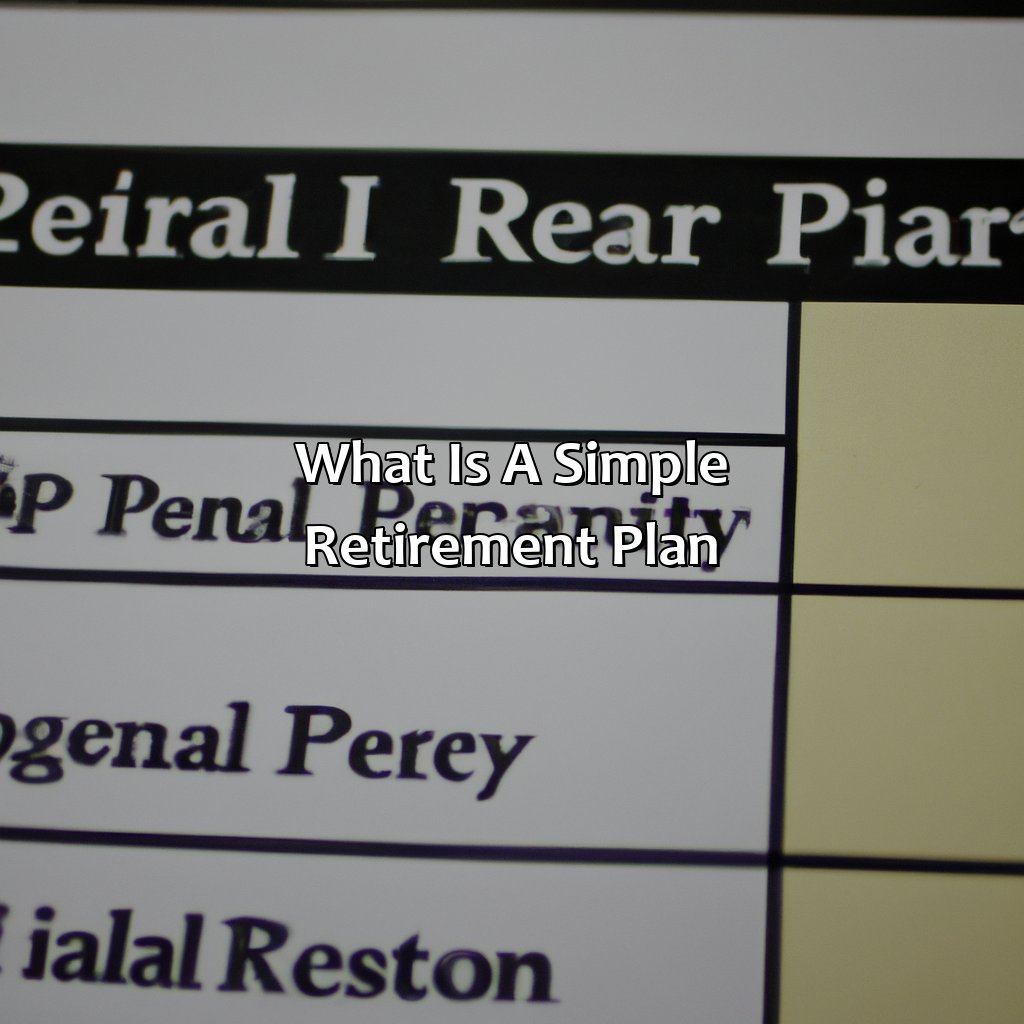What Is A Simple Retirement Plan?
Key Takeaway:
- A Simple Retirement Plan is an excellent choice for small businesses and individuals seeking an easy-to-understand and administer retirement plan.
- There are two types of Simple Retirement Plans: the Simple IRA and the Simple 401(k), which have similar contribution limits but differ in eligibility requirements and administration.
- Employers and employees alike benefit from a Simple Retirement Plan, with advantages such as tax-deferred contributions, lower administrative costs, and increased savings compared to traditional retirement plans.
Are you concerned about securing a comfortable retirement? With the right planning and investments, you can confidently create a retirement plan that gives you peace of mind. Read on to find out what is a simple retirement plan and how it can help you plan for a worry-free future.
What is a Simple Retirement Plan?
A Simple Retirement Plan, or a Savings Incentive Match Plan for Employees (SIMPLE), is a type of retirement plan designed for small businesses that have 100 employees or less. It allows employees to contribute to their retirement savings account via salary reduction, while the employer is required to make contributions as well. The contributions are tax-deductible and grow tax-deferred until withdrawal during retirement.
SIMPLE plans provide a cost-effective and easy-to-manage option for small businesses to offer employees retirement benefits. The employer can choose to contribute a matching amount, up to 3% of the employee’s salary, or make a non-elective contribution of 2% of the employee’s salary. The employee can contribute up to $13,500 per year, with catch-up contributions available for those over 50 years old.
One unique feature of SIMPLE plans is that they have a lower contribution limit compared to other retirement plans, such as 401(k) and IRA plans. However, they also have lower administrative costs and are easier to set up and maintain.
According to a study by Vanguard, SIMPLE plans have a high participation rate among employees, with around 83% of eligible employees contributing to their account. This highlights the effectiveness of SIMPLE plans in encouraging employees to save for retirement.

Image credits: retiregenz.com by Adam Woodhock
Definition and Importance of a Simple Retirement Plan
A Simple Retirement Plan is a tax-advantaged retirement savings account suited for small businesses with fewer than 100 employees. It offers easy administration, low cost, and flexible contribution options for both employers and employees. In today’s uncertain times, it’s crucial to save for retirement, and a Simple Retirement Plan provides a hassle-free method to ensure a secure financial future.
The importance of offering a Simple Retirement Plan to employees cannot be overstated as it helps attract and retain top talent while promoting loyalty and job satisfaction. For employers, it’s an excellent tool to reduce taxes while saving for the future. As an added benefit, employees can enjoy tax-deferred contributions, and employers can deduct matching contributions as a business expense. The simplicity of the plan allows both parties to focus on business growth without worrying about complex rules and regulations.
Employers must contribute either a 2% flat contribution for every eligible employee or match employee contributions up to 3% of their salary. Employees can contribute up to $13,500 annually to their Simple Retirement Plan account. These accounts are self-directed, allowing employees to choose from various investment options to maximize their savings.
A small business owner, Sarah, started a Simple Retirement Plan for her employees, and it has proven to be a valuable benefit for employee retention. One of her long-term employees chose to stay with the company, in part, because of the retirement plan. The employee appreciated the ease of contributing to the plan and the sense of security it provided in terms of financial planning for their future.

Image credits: retiregenz.com by Yuval Jones
Eligibility for a Simple Retirement Plan
Are you eligible for a simple retirement plan? If so, find out! Two types of people can take advantage of this – business owners/self-employed and employees of small businesses. Investigate the eligibility section to secure your future.

Image credits: retiregenz.com by Harry Jones
Business Owners and Self-Employed Individuals
Individuals who are self-employed or have their own businesses may be eligible for a retirement plan known as a Simple Retirement Plan. This plan offers tax benefits and can help individuals save for retirement without the burden of complex administrative requirements. Contributions are made by both the employer and employee, with limits on how much can be contributed annually. It is important for business owners to familiarize themselves with the eligibility requirements to determine if this plan is suitable for their needs.
In addition to being an easy-to-administer retirement option available to small businesses, a Simple Retirement Plan allows employees to contribute pretax income, providing tax savings that can help them grow their retirement savings faster. Employers also benefit from the plan by being able to offer their employees a valuable benefit while keeping costs low. Eligibility is restricted to businesses with fewer than 100 employees who earned at least $5,000 in compensation during the previous year.
Pro Tip: Business owners should consider exploring various retirement options and consult with a financial advisor before making any decisions about which plan is right for them and their employees.
Working for a small business may mean less job security, but at least you can retire with a Simple Retirement Plan that’s not so simple to understand.
Employees of Small Businesses
Small business workers may be eligible to participate in a Simple Retirement Plan, known as “Savings Incentive Match Plan for Employees” (SIMPLE). It allows employees to contribute pre-tax dollars into a retirement account, and employers can match up to 3% of the employee’s income. This plan is designed to help small businesses offer employees an easy option for saving money towards their retirement.
The SIMPLE plan has two options – a traditional IRA or a 401(k) plan. Both options have limits on contributions and penalties for early withdrawals. The employer is responsible for administering the plan and choosing which option works best for their company and employees.
Participation in the SIMPLE plan does not affect eligibility for other retirement plans such as Social Security or pension plans. However, if an employee participates in both a SIMPLE IRA and another employer-sponsored retirement plan, the contribution limits are reduced.
According to Forbes, only around 12% of small businesses offer a retirement savings program like the SIMPLE plan.
Who needs a yacht when you can have a Simple Retirement Plan? The benefits may not come with a captain’s hat, but they’re definitely more practical.
Benefits of a Simple Retirement Plan
Want to reap the rewards of a basic retirement plan? Think about using this easy solution. This can incentivize employees and create loyalty, plus offer employers tax advantages. Find out the pros of the two parts and how a simple retirement plan is a brilliant investment for both sides.

Image credits: retiregenz.com by Adam Woodhock
Employer Benefits
In light of the Semantics of employer Benefits, let’s dive into the advantages of adopting a Simple Retirement Plan (SRP).
- SRPs are cost-efficient: Employers save on administrative costs and tedious paperwork.
- Low maintenance: It requires minimal paperwork while ensuring retirement security for employees.
- Tax benefits: Contributing towards employee SRP accounts is tax-deductible which reduces the employer’s taxable income.
It should be noted that SRPs abide by specific eligibility criteria, which we’ve covered in detail earlier.
By incorporating an SRP, employers guarantee retirement benefits to employees at no significant overhead cost. Adopting such a plan not only stabilizes the workforce but also promotes long-term job satisfaction.
Join hands with us today and get started on your company’s path towards greater stability and prosperity.
Who needs job security when you can have employee benefits? Just kidding, we all need a little bit of both.
Employee Benefits
Employee Perks: Understanding the Benefits of Company-sponsored Assistance Programs
Companies offer various assistance programs to support their employees. Employee Perks may include the following:
- Health Insurance: Coverage for medical expenses and related costs such as prescription drugs and hospitalizations.
- Retirement Plans: In addition to the simple retirement plan, employees can also opt for 401k or pension plans that enable long-term savings.
- Paid Time Off: Vacations, sick days, bereavement leave, maternity or paternity leave, etc. help maintain a healthy work-life balance.
- Career Development: Access to professional development opportunities such as training courses and workshops that aid in skill enhancement and progression.
Employers may offer additional support programs such as legal assistance, childcare subsidies, commuter benefits, etc., tailored to employee needs.
It’s been found through a Glassdoor survey that 57% of people indicate that benefits and perks are among their top considerations when deciding on a job offer. Who needs a fancy retirement plan when you can just stick with the tried-and-true ‘stash your cash under the mattress’ strategy?
Types of Simple Retirement Plans
Different types of simple retirement plans, like Simple IRA and Simple 401(k), can be understood. Solutions exist to help with this. These plans offer small businesses an easy and inexpensive way for their staff to save for retirement.

Image credits: retiregenz.com by Harry Jones
Simple IRA
A Simple IRA plan is a type of retirement plan which is easy to administer and maintain. It offers benefits like employer contributions, tax-deferred growth and employee salary deferrals. A small business with fewer than 100 employees can establish this plan.
The contribution limits for Simple IRA plans are lower than other types of retirement plans such as 401(k), but the set-up costs are also lower. Employees can contribute a fixed amount or a percentage of their salary, and the employer can choose to make matching contributions up to a certain percentage.
One unique feature of Simple IRA plans is that they allow participants who are over 50 to make catch-up contributions, which allows them to make additional contributions beyond the annual limit. This can be beneficial for individuals who started saving later in life or have had financial setbacks.
If you’re a small business owner looking for an affordable retirement plan option for you and your employees, consider setting up a Simple IRA plan. Don’t miss out on the opportunity to take advantage of tax-advantaged savings and help your employees save for their future. Start socking away some cash now, because by the time you retire, avocado toast will probably cost $50 a pop – thank you, Simple 401(k)!
Simple 401(k)
A straightforward 401(k) plan, called a ‘Simple’ retirement plan is an employer-matched investment account that allows employees to save money for the future. It has lower contribution limits than traditional 401(k)s and no profit-sharing contributions.
With a Simple 401(k) plan, employers with fewer than 100 employees can make contributions toward their employees’ retirement savings and receive tax benefits. Employees also have the option to contribute pre-tax dollars through automatic payroll deductions. Withdrawals of the fund before age 59 1/2 will be subject to taxes and penalties.
It’s important to note that participants can only have one Simple 401(k) account at a time, making it important for participants to choose an appropriate investment strategy that aligns with their long-term goals.
One small business owner in Florida decided to set up a Simple 401(k) plan for his five employees as a way to attract and retain talent. He found that offering this type of benefit improved employee satisfaction and loyalty, making it a worthwhile investment for both himself and his team.
Save for retirement, or spend your golden years asking if anyone wants fries with that- the choice is yours with simple retirement plans.
Contributions and Limits for Simple Retirement Plans
Figuring out how to handle and maximize a Simple Retirement Plan? Consider the Contributions and Limits. In this piece, we’ll explore the key factors for optimization.
Three sub-sections:
- Employer Contributions
- Employee Contributions
- Contribution Limits
Need to know to boost your plan!

Image credits: retiregenz.com by Harry Woodhock
Employer Contributions
Employer contributions are the funds that employers put into an employee’s retirement plan. These contributions are an essential aspect of a retirement plan and can provide a substantial benefit to employees.
- Employers may contribute a specified dollar amount or percentage of compensation to the employee’s account each year.
- Contributions should be made by the employer on behalf of eligible employees only.
- Employers must make contributions timely, within 30 days after the end of the month in which they diverted the amounts from their business assets.
- An employer may choose to match some or all of an employee’s contribution, up to 3% of their salary per year in case if Plan elects “basic matching”
- The maximum amount for SIMPLE IRA contributions changes yearly but is subject to Internal Revenue Service (IRS) limits.
- If you’re a sole proprietor who has an employee or two, those workers will have accounts set up under your name and taxpayer identification number as participants in your Simple IRA plan.
It’s important to note that employers have limits on how much they can contribute. For instance, in a SIMPLE IRA plan, in 2021, A “catch-up provision” allows workers who are age 50 and older to make extra contributions up $3000- add it on $13000[1].
Interestingly enough, small companies owners often choose this type because it was available during its enactment at late 1990; now enterprises with more than one employee can offer multiple retirement plans; besides now Bigger companies may elect for other defined contribution plans – such as Simplified Employee Pension Plan(SEP) 401(k), etc., which could provide higher deduction limits.
Reference:
[1]https://www.irs.gov/retirement-plans/simple-ira-plan-faqs-contributions
Retirement savings may be the only thing simpler than a simple retirement plan – just ask your broke uncle.
Employee Contributions
When it comes to contributions made by employees, there are certain guidelines that must be followed within a Simple Retirement Plan.
- Employees can contribute up to $13,500 annually in 2021.
- Those aged 50 or older can also make catch-up contributions of up to $3,000 per year.
- Contributions are made pre-tax and reduce taxable income for the year they are made.
- The employer is required to match employee contributions up to 3% of their salary or provide a non-elective contribution of 2% of all eligible employee’s salaries.
It’s important to note that these contribution limits and requirements may change from year to year, so it’s essential to stay informed with current regulations.
To ensure employees are taking full advantage of their retirement plan, employers can offer education sessions or one-on-one meetings where employees can learn about optimal contribution amounts and investment strategies. Encouraging regular reviews of contributions and investments are other ways employers can help their employees maximize the benefits of their Simple Retirement Plan.
Don’t worry about hitting the contribution limit for your simple retirement plan, just remember that the more you save, the less you’ll have to rely on cat food for dinner in your golden years.
Contribution Limits
The maximum allowable contributions for a straightforward retirement scheme have certain limitations. Employers may contribute up to $13,500 annually, while workers are permitted to contribute up to $11,000 annually, according to the IRS. Contributions that exceed these limits will result in fines and costly taxes. Additionally, employees over the age of 50 are granted “catch-up contributions” totaling up to $3,000 annually. Any further contributions must be predetermined and specified via an agreement.
Pro Tip: Companies that offer their employees savings plan matching benefits can maximize their allowable annual contribution amount by combining employer matches with employee deferral contributions.
Who needs enemies when you have taxes to take away your hard-earned retirement savings? #WithdrawalWoes
Withdrawals and Taxes
Retirement accounts under the Simple Retirement Plan (SEP) allow for penalty-free withdrawals starting at age 59 and a half. Withdrawals from SEP accounts are taxed as ordinary income. The earlier distribution taken from a SEP account, the higher the penalty and taxes. To avoid penalty, making withdrawals after 70 and a half is mandatory.
SEP accounts do not offer Roth contributions, thus all qualified distributions will be taxed as ordinary income. It is essential to monitor and report traditional IRA contributions as well as conversions to Roth IRA. Overlooking these may cause errors in taxation. The IRS imposes a 50% penalty for withdrawing or rolling over any converted amounts before a 5-year holding period.
Under SEP, contributions are made with pre-tax money, withdraws are taxed at your income tax rate, and there are rules for the distribution of your funds. Be aware of Required Minimum Distributions, as they begin at age 70 and a half. Overlooking RMD can result in a 50% penalty on the amount not distributed.
According to the IRS, in 2021, the maximum salary reduction contribution that can be made to a SEP account is $58,000 or 25% of the participant’s compensation, whichever is less.
(Source: IRS.gov)

Image credits: retiregenz.com by David Woodhock
Setting up a Simple Retirement Plan
A simple retirement plan is an excellent option for those who want to enjoy a comfortable retirement. To set up such a plan, you can follow these four easy steps:
- Decide on a retirement goal.
- Choose a suitable account type.
- Make contributions.
- Monitor and adjust your plan regularly.
It is important to note that simple retirement plans have unique features that make them stand out from other types of retirement plans. For instance, the contribution limit is relatively low, and there are no annual filings required.
A few years ago, a successful entrepreneur decided to retire. Despite his significant wealth, he realized that he did not have an adequate retirement plan in place. He set up a simple retirement plan and made contributions regularly. Over time, he realized that he was on track to enjoy a comfortable retirement. He was grateful for the ease and simplicity of the plan, which allowed him to focus on enjoying his retirement rather than worrying about finances.

Image credits: retiregenz.com by David Washington
Five Facts About Simple Retirement Plans:
A Simple Retirement Plan (SEP) is a tax-deferred retirement account that allows small business owners and self-employed individuals to save for retirement. (Source: The Balance)
Contributions to a SEP are tax-deductible, and there are no taxes on earnings until they are withdrawn. (Source: IRS)
SEP contributions limits for 2021 are $58,000 or up to 25% of an employee’s compensation, whichever is less. (Source: Fidelity)
SEPs are easy to set up and have low administrative costs, making them a popular choice for small businesses. (Source: Investopedia)
SEPs can be used in conjunction with other retirement plans, such as a 401(k) or IRA, to maximize retirement savings. (Source: NerdWallet)
FAQs about What Is A Simple Retirement Plan?
What is a Simple Retirement Plan?
A Simple Retirement Plan (or “Savings Incentive Match Plan for Employees”) is a type of retirement option available to small businesses with 100 or fewer employees. It allows employees to make pre-tax contributions to their retirement accounts, and employers to either match the contributions or make a fixed contribution to the account.
Who is eligible for a Simple Retirement Plan?
Any small business with 100 or fewer employees can offer a Simple Retirement Plan. Both full-time and part-time employees who have received at least $5,000 in compensation from the employer in any two preceding years and are expected to receive at least $5,000 in the current year are eligible to participate.
What are the benefits of a Simple Retirement Plan?
A Simple Retirement Plan offers numerous benefits, including a low administrative burden, tax benefits for both employers and employees, and the ability to contribute a significant portion of an employee’s salary to their retirement account.
What are the contribution limits for a Simple Retirement Plan?
For 2021, employees can contribute up to $13,500 to their Simple Retirement Plan accounts, and employees over age 50 can contribute an additional $3,000 as a catch-up contribution. Employers can either match employees’ contributions dollar-for-dollar up to 3% of their compensation or make a fixed contribution of 2% of each eligible employee’s compensation.
What is the deadline for setting up a Simple Retirement Plan?
Employers can set up a Simple Retirement Plan any time between January 1st and October 1st of the year they wish to start the plan. Employees must be notified of their eligibility to participate in the plan within a reasonable period before the 60-day election period.
How does a Simple Retirement Plan differ from other retirement plans?
A Simple Retirement Plan is similar to a 401(k) plan in terms of tax benefits and contribution limits, but it has lower administrative costs and simpler rules for employers to follow. It is also unique in that it requires employers to make either a matching contribution or a fixed contribution to their employees’ accounts.
 Checkout this IRS Loophole
Checkout this IRS Loophole 





